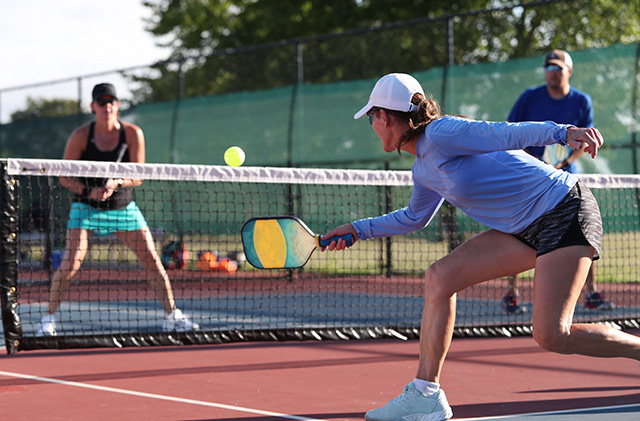Play it Safe: Common Pickleball Injuries and How to Prevent Them

Pickleball has quickly become one of the fastest growing sports in America. It is a great way for players of all ages to socialize and play a relatively low-impact sport that helps keep you in shape. On top of that, Pickleball is easy to learn, doesn't require a lot of expensive sports equipment, and can be played indoors and outdoors.
Its rise in popularity also means a rise in racket sport-related injuries. The Pickleball commonly sees most of its injuries come from newer players, or highly active players due to the strain on their wrists, knees and ankles. Below are some common Pickleball injuries, how to treat them, and the best ways to help prevent them.
What are the Most Common Pickleball Injuries?
The most common Pickleball injuries are sprains on your knees and ankles, as well as wrist pain.
Wrist Pain Caused by Pickleball
Do you experience wrist pain when playing or after playing Pickleball? Tendonitis, and sprains/strains are the most common Pickleball wrist pain and injuries.
Tendonitis is the inflammation or swelling of the tendons and is usually caused by overuse. Both tendonitis and sprains/strains can be treated with physical therapy, anti-inflammatories, rest, ice, compression and elevation, and splinting.
Knee Injuries Caused by Pickleball
Pickleball requires a lot of quick pivots that add stress to your knees. Overexertion can lead to strains and sprains, and in some severe causes, a torn meniscus.
Symptoms of a torn meniscus can include:
- A popping sensation or clicking sound in your knee
- Swelling
- Stiffness
- Pain when twisting your knee
- Locking of your knee
- Weakness or the feeling that your knee is giving away
A torn meniscus might heal on its own with a combination of rest, ice, pain medication, and physical therapy over a period of several months. However, a more severe tear might require surgery.
Ankle Injuries Caused by Pickleball
Common Pickleball ankle injuries are usually sprains and strains, though falls and wrong movements can lead to a sprained or torn Achilles tendon. The Achilles tendon is the largest tendon in your body and runs from the back of your heel up to behind your knee. Sprains are treated with rest and medication to help with the swelling and pain.
A torn Achilles may require surgery, a long period of rest, and/or physical therapy to heal. Symptoms can include pain, inability to stand on your toes or bend your foot forward, popping, and swelling.
How to Reduce the Risk of Pickleball Injuries
The best way to reduce the risk of a Pickleball injury is to strengthen your wrists, knees, and ankles.
Try Heel Raises for Your Ankles
For your ankles, try heel raises for Pickleball injury prevention. Heel raises are an easy and low-impact exercise that improves the architecture of your lower leg muscles and ankles. They can reduce ground-reaction forces, such as a hard pivot or running, which can reduce your risk of injury.
- Hold on to a counter or table for balance
- Stand with your feet about hip-width apart and your toes pointing forward
- Slowly raise your heels as high as they can go, then lower them just as slowly
- Repeat this several times depending on your comfort level
Strengthen Your Knees with Side-Lying Leg Lifts
The side-lying leg lift works the entire leg, all the way up to the hip. Building overall leg strength helps protect your knees. This exercise works out your entire leg, which helps add more muscle, flexibility, and cushioning to your hips, and helps with increasing your range of movement.
- Lie on your side, with your hips “stacked” on top of each other
- Slowly lift your top leg and keep your knee straight and slightly behind you
- Slowly raise it as high as you feel comfortable
- Slowly lower your leg before lifting it again
- Repeat several times, then switch sides
Build Strength in Your Wrist by Playing
The best way to prevent Pickleball-related injury, especially when it comes to your wrists, is to practice. The more you use a specific muscle group, the stronger it will become. If your wrist hurts, rest it and ice it for a few days before slowly easing back into playing Pickleball. As an additional safety measure, you might consider using a wrist brace to help prevent Pickleball related injuries.
Can I Still Play After a Pickleball Injury?
After the right amount of rest and the right treatment, most people can return to playing Pickleball. However, if you experience any of the symptoms related to more serious injuries like a torn meniscus or torn Achilles tendon, you should stop playing and contact one of our qualified knee, wrist, or ankle specialists for an examination as soon as possible.
NY Orthopedics Specialist Office Locations
NY Orthopedics has multiple offices in New York City, including Manhattan, Brooklyn, and Staten Island, as well as the surrounding counties, including Nassau, Westchester, and Rockland. If you’re experiencing any symptoms of a torn meniscus or torn Achilles tendon, please contact us today.
